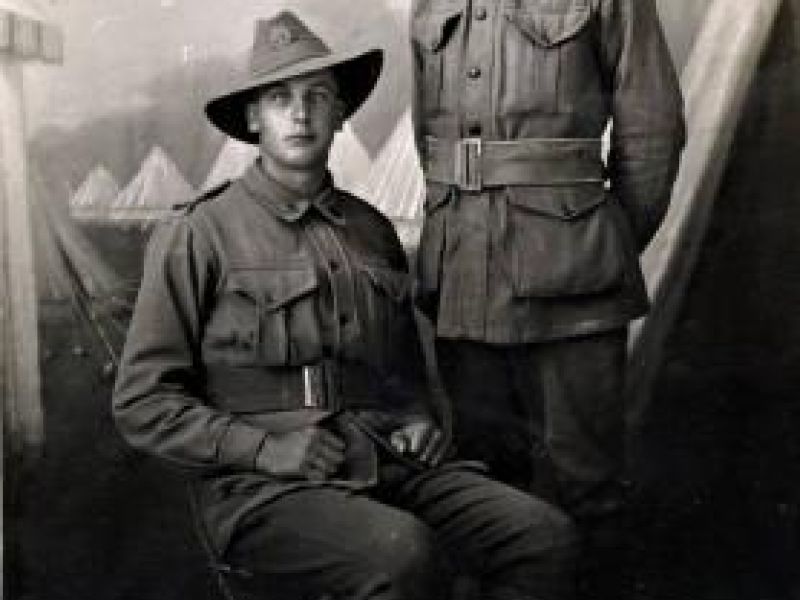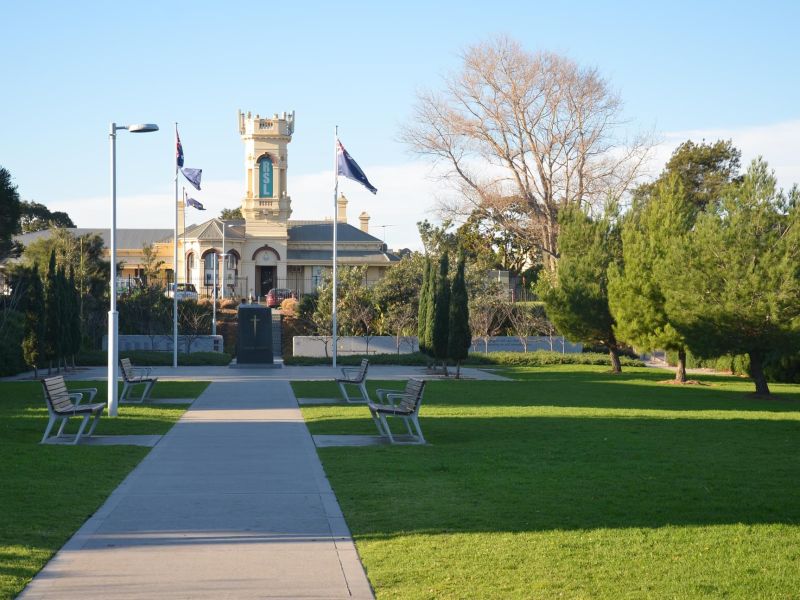Arthur Sydney Wilson
Arthur Sydney Wilson was born on the 8th of September, 1896, at Tintaldra. He was one of six children to Sydney Alexander and Evelyne Matilda (née Donelan). His early days would see a number of tragedies with his mother dying in 1899 and a sister (Arabella) dying in 1906. Prior to these two deaths, the family had a son, the first to be named Sydney, who died at only 3 months in 1888. Arthur’s father married Daisy Hastings shortly after Evelyne’s death. Arthur would have two step-brothers as a result of this marriage.
Sometime before Arabella’s death, the family moved from Walwa to Balwyn near Melbourne. There would be further moves within the Melbourne suburbs over the next few years, however the family would name their house in Collins Street, Cheltenham “Walwa” after their first hometown.
Arthur (sitting in photograph at left) would enlist in the 1st AIF in Melbourne on the 26th of January, 1917, becoming part of the 7th Reinforcements for the 38th Battalion. He had previously served in the Victorian Cadets and the 29th Light Horse, but had initially been rejected for enlistment due to having a hammer toe on his left foot. After initial training at the Broadmeadows Camp, just outside of Melbourne, the 7th Reinforcements embarked on HMAT A70 Ballarat. Arthur was joining three other men from the Upper Murray who were in the 38th Battalion; Patrick White, Thomas Robinson and Henry Woodhouse.
Arthur was a passionate letter writer, with many of his letters surviving the years. On March the 10th, he wrote to his older sister, Mary. He commented that the voyage had settled down since leaving Fremantle with a lot of time spent engaged in sporting activities. He suffered his first wound on board ship when a fellow soldier threw a cat onto his face while he was resting in his hammock. The cat scratched both his lips and, being thoroughly annoyed, he punched the offending soldier causing him to bleed from the mouth and nose. In addition to sport there was a church parade each Sunday morning and a sing song service at night. He joined a bible class and, although it only had five members initially, he expected it to grow by the following Sunday.
Arthur survived the sinking of the troopship on the 19th of February. He recorded his thoughts in another letter to Mary where he wrote:
“It was a bit of a shock to us I can tell you but no one was drowned. I saw the torpedo before it hit the boat. When it hit the side of the boat it exploded and made a row like one of the big guns on a battle ship [sic]. I had a bit of a swim but soon got picked up by one of the destroyers. … I can tell you it is very cold over here. We lost all our kits and I lost the scarf you gave me. I saved the wallet and cigarette case but I was not allowed to go down and get my kit bag so I lost all my clothes.”
Upon arriving in England, the 7th Reinforcements became part of the 10th Training Battalion. During this time Arthur was posted as being absent without leave for a period of four days. This was a common misdemeanour for Australian troops as they often went out exploring a foreign place. Many of them had never moved far from their own home, let alone visit a new country. He was awarded six days field punishment No 2 and forfeited 10 days pay. Two months later he spent two weeks in the Tidworth Military Hospital suffering from infection of unknown origin.
In mid September of 1917, Arthur proceeded overseas to France to join the 38th Battalion in the field. He was there in time to be present at the inspection of the entire 3rd Australian Division by the Commander in Chief Field Marshal, Sir Douglas Haig, near Drionville, France. Over the coming week, the battalion would march from Drionville to Winnizeele in northern France, a distance of over 40 kilometres. On the 4th of October, the 38th Battalion took part in the fourth phase of the 3rd Battle of Ypres, often referred to as the Battle of Passchendaele. This battle would be remembered for the three weeks of continuous rain in the opening stages, which began on the 31st of July, and the casualties, with over 250,000 soldiers killed, wounded or missing on the Allied side. The 38th Battalion would record a 63% casualty rate at the conclusion of the battle in November.
On the 13th of October, Arthur was posted as being missing in action and then, two weeks later, as being killed in action. Arthur’s body was never found, and he is remembered at the Menin Gate Memorial, Ypres, West-Vlaanderen, Belgium.
Arthur is remembered on the Australian War Memorial Roll of Honour, the Menin Gate Memorial in Ypres, Flanders, Belgium, the Mentone Memorial Gardens, and the Mentone St. Augustine’s Anglican Church Memorial Window. For his service during the First World War, he was awarded the British War Medal and the Victory Medal.

 Stephen Learmonth
Stephen Learmonth